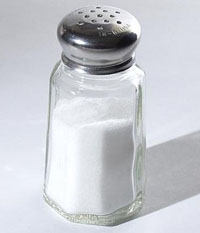
Salt is one of the most important ingredients ever discovered. It’s uses are so wide and extremely significant that even historic wars and battles have been fought for it. Salt has a wide use when it comes to food preparation. Salt not only gives food flavoring, providing a much-needed flavor to what otherwise would be bland food, provides nutritional benefits, but it also is used for food preservation.
Salt is absolutely indispensable, but there’s something we should all know about salt. Most of the time, the salt that we are using is unhealthy and we don’t even know it. Another thing that we don’t know is that there is a pure salt that we can replace the not-so-healthy salt that we’re using everyday. Let’s weigh in on the three kinds:
1. Table Salt or Sodium Chloride – This is the most common type of salt that we see in the kitchen and it comes in coarse or very fine form. Some countries still use the coarser version of table salt, but in the US, coarse table salt has been done away, replacing it with the finest grains of salt. Most often this kind of salt is one that has to be bleached and stripped of minerals. We can see from here that the table salt has some very bad “cons” to it, as the salt undergoes too much processing for it to be called natural or organic, or at the very least ‘healthy’.
Sodium Chloride is harmful to the body as it introduces toxins that the body will have trouble expelling. It is a well known fact that pure Sodium Chloride causes dehydration. It occurs when the body tries to extract water from cells as a way to recuperate the damage the toxins from the salt have wrecked havoc on. Some have countered that table salt isn’t pure Sodium Chloride. To a length, it is right, but the fact remains that table salt is around 98% Sodium Chloride and just around 2% of good minerals like iodine.
2. Sea Salt – Commonly known as the healthier, organic alternative to processed table salt. But a closer look under a high-powered microscope would reveal that sea salt has irregular structures that separates the minerals. The body will have very little to gain as the minerals in the isolated structure is something that’s not easy to absorb.
When it comes to harvesting sea salt, there are additional issues. The seas have become more polluted; the oceans have been exposed to all kinds of things, such as human-produced garbage, and to even more deadly chemicals like factory wastes, oil sludge, mercury, dioxins and all other pollutants that harm us. A huge amount of the toxins are being absorbed in the salt, which makes the sea salts in the market today not a very good alternative to table salt.
3. Himalayan Salt – A relatively new discovery has led experts to believe that this might just be the only toxin-free salt in the world. Though it’s something new for most of us, it has been around for 250 million years. It is produced by the earth and it has been found to be one of the purely natural food item in the world and is entirely toxin-free and full of minerals that have been lost in other salt forms.
Compared to the Sea Salt, the crystalline structure in the Himalayan Salt has a more abundant mineral content – 84 mineral elements to be exact. Additionally is has a structure that is easily absorbed by the body unlike sea salt. Himalayan salt can come in a solid form or in granulated form. Gourmet chefs who use Himalayan salt use blocks of the salt formed into bowls and pots and cook directly from it. In everyday use, a finely grained Himalayan salt is more appropriate.
The only con of Himalayan Salt is its price. It’s not something you can easily find in the market as the salt source itself is very limited. This precious salt is mined from the government-controlled land of the Himalayan Mountains. However, there are many great websites on the internet where you can purchase Himalayan salt as a good price if you’re looking to live healthier.
No Comments »
No comments yet.
RSS feed for comments on this post. TrackBack URL
Leave a comment
Comments (0)